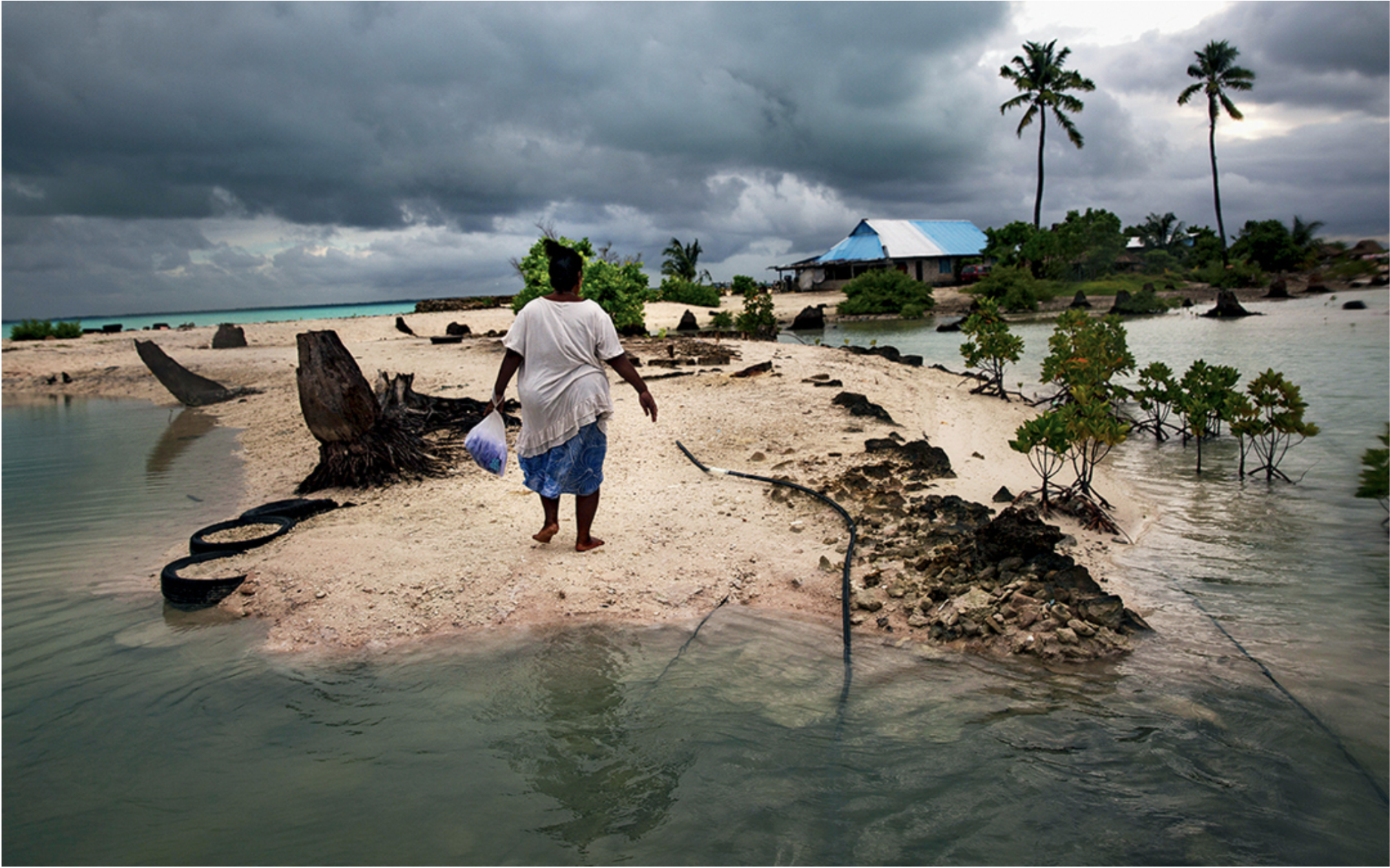
FELIX ZHANG- APRIL 17, 2023
EDITOR: ABBY MORRIS
The impact of climate change is not a matter of if, but when: since 1880, the average global surface temperature has risen by 2℉. These rising temperatures have produced obvious ripple effects in ecosystems and climate patterns throughout the globe, leading to widespread changes in how our world behaves. Higher temperatures have led to increased levels of ice melting in places like Greenland and Antarctica, producing the dangerous potential to change expected weather patterns and average ocean temperatures. Furthermore, rising temperatures can have huge impacts on flora and fauna biodiversity as species become forced to migrate, adapt, or go extinct in the wake of earlier spring seasons, more droughts, and severe flooding.
While we often hear about the myriad of harmful effects stemming from climate change, we seldom hear about its disproportionate effects on different countries, and the notably worse effect it has on developing nations. According to the World Bank, climate change has the potential to push between 68 to 135 million people into poverty, which would reverse decades of economic progress and cause inequality between countries to rise. Factors such as poor geography, lack of capital, and unstable political institutions exacerbate the challenges of climate change for poorer nations, making it far more difficult for these countries to grow and accommodate to the new challenges that an evolving global climate brings about.
Rising sea levels
One of the biggest impacts of climate change felt around the world are rising sea levels. Since 1900, sea levels have risen by over 23 centimeters: equivalent to an increase of 9 inches. While rising sea levels are a global issue, rich countries are far better equipped to combat the problem. In the Netherlands, a country that is largely at or below sea level, an advanced $2.5 billion system of dams, seawalls, and embankments helps reduce the likelihood of flooding by a factor of ten. Elsewhere, the Maldives, an Indian Ocean island nation that has become rich due to a booming tourist sector, has created an artificial island spanning 4 square kilometers named Hulhumalé that has a higher elevation than the rest of the country. Hulhumalé is already home to 50,000 residents and could see up to 200,000 more people move there, from both within the Maldives and around the rest of the world. Furthermore, the Maldives has been able to construct sea walls for their existing islands, and the state has also explored the possibility of purchasing higher ground in other countries for relocation if necessary. Economically prosperous countries have the financial and political resources to get these types of projects accomplished, even at immense costs, but many other nations do not.
Some 8,000 miles away in the Pacific, Kiribati faces a much tougher challenge. While the current political administration in Kiribati has announced plans to raise the island nation’s major territories by one meter in order to prevent the flooding they are particularly susceptible to, questions remain as to who will finance the project. While Kiribati’s growing relationship with China and the acknowledgment of Kiribati’s situation by international billionaires point to some potential sources of capital, no promises have been made. Kiribati has long dealt with poverty and a low GDP per capita due to a variety of factors. These factors include its isolated location in the Pacific, which reduces tourism potential and increases reliance on international imports. Economic mismanagement has caused natural resource depletion, lack of skilled workers, and high unemployment. Finally, social issues have resulted in large families and women unable to find work. Kiribati’s GDP per capita in 2021 USD stood at a paltry $1,606.5, making it the poorest state in Oceania and one of the poorest in the world. What income streams that do exist in Kiribati’s economy are largely centered around fishing, emigrant remittances, and international assistance.
What would happen to Kiribati if they were unable to raise their ground? With 2/3 of its land projected to be underwater from a sea level rise of 3 feet — a number expected to be reached by the end of the century — Kiribati’s inability to raise their ground would likely create a climate refugee crisis. Not just an issue exclusive to island nations, rising sea levels could also have potentially devastating impacts among urban areas in developing countries along the coast. If current rates of rising sea levels continue, major regional cities like Lagos, Nigeria and Dhaka, Bangladesh, which are home to a combined population of over 50 million people, could face serious flooding and displacement issues given a lack of international action and the inability to construct necessary infrastructure.
Farming in the age of climate change
Another huge impact of climate change on developing countries relates to the agricultural sector. Around the globe, nearly 700 million people are considered undernourished, with the vast majority of these people living in Africa, Latin American, and the Caribbean: places located close to the equator. The geography of these malnutritioned nations is particularly related to crop resilience being lower in these higher temperature areas. A study looking at farm vulnerability in the United States found that farms in the southern regions of the US were more susceptible to issues caused by rising temperatures than farms in the northern regions, and this trend would likely continue the closer farms get to the warmest regions of the world. Most crops can only tolerate a maximum heat, and anything above that maximum would make planting a large number of grains, fruits, and vegetables extremely difficult to near impossible. Because of this, a seemingly minor increase in temperatures by just a few degrees in certain parts of the world could be incredibly devastating to farming.
In Zimbabwe, many farmers have already moved away from the staple crop of rice due to the lack of wetlands caused by increasingly warm and dry farming seasons. This also applies to a number of popular grasses that were cultivated to feed livestock, which are no longer being planted due to the harsher environment. While dry seasons used to affect the southern African nation once every five years, dry seasons might now be experienced in back to back years. For Zimbabwean farmers, two years of negative profits would be financially devastating, especially given their country’s historically shaky economy and political system.
These problems would have serious economic implications in developing countries. According to the World Bank, while accounting for only 4% of global GDP, agriculture can constitute more than 25% of GDP in developing countries and hover around 30% of total GDP in Sub-Saharan Africa. Furthermore, the World Bank finds that growth in the agriculture sector is two to four times more effective than other sectors in raising incomes among the poorest. If climate change induces lower crop yields, this could significantly disrupt agricultural growth in developing nations, and accordingly disrupt their overall growth as a nation. In countries with high employment in agriculture, lower yields could also lead to high levels of unemployment as labor becomes more obsolete with less productive land.
This is not to mention the significant impacts that stem from increased malnourishment in parts of the world that already face food insecurity problems. The WHO finds that stunting, which is mostly associated with low height-for-age as well as low weight-for-age, can have significant impacts on the physical and cognitive development of children, especially those in poor socioeconomic status who often cannot receive proper healthcare. On the other hand, a lack of local and healthy produce due to diminishing crop yields could force countries to resort to importing a greater amount of cheap, heavily-processed foods that are high in fat and sugar and could lead to an increase in obesity rates or other related health problems. Both of these health factors would affect the economic growth of developing countries in the form of potential lost productivity, lower wages, and diminished human capital, while driving up the costs of healthcare for already financially strained households. Thus, climate change’s impact on agriculture has many ripple effects -– the most notable being slower economic growth, job loss, and an increase in malnourishment or health problems.
Building a global green economy
Climate change simply cannot be solved by rich and resource laden countries using temporary stopgap measures such as building seawalls, providing agricultural subsidies to their domestic farmers, and setting unrealistic emission reduction targets. Instead, there must be a global effort to actively mitigate the damage done by climate change, while recognizing that it has already begun to disproportionately impact poorer countries across the world. Keeping that in mind, it is important to note that current efforts to diminish the impacts of climate change could have negative effects on the world’s poorest by driving up energy and food costs, which are often two of the largest components of consumption for individuals with lower incomes. However, this is not an excuse for inaction — doing nothing would have an even larger impact on poor countries in the long run — and there are a variety of ways that international action on climate change can be leveraged to create a more equitable world while not setting back developing countries.
To allow smallholder family-operated farms in developing countries to create climate-resilient agricultural solutions, the international food security organization CGIAR has created hardier, more nutritious crop varieties, introduced eco-friendly farming practices, and implemented digital tools to help farmers better understand changing weather patterns. Research has shown that every dollar provided to CGIAR has created ten dollars in benefits, largely in the form of net returns for individual farmers. Creating a more sustainable farming model in parts of the world like Africa and South Asia has the potential to spur economic development, turning CGIAR’s research, outreach, and funding into an asset for future growth.
Additionally, it should be the responsibility and obligation of rich countries to finance climate-related projects in countries that cannot afford to pay for the infrastructure on their own. With the population of the wealthiest 16% of nations accounting for over 40% of global emissions, and the poorest 60% of the world’s population accounting for only 15% of total emissions, the direct cause of climate change should fall squarely on the shoulders of rich nations. If legislation like a carbon tax is passed, it would be logical to partition a portion of the tax’s revenues towards developing countries that are most at risk from climate change. Wealthier countries can also leverage the financing of climate-related projects in poor nations for future benefits, such as trade agreements and improved diplomatic ties.
This brings up an important point about the role of poor nations in creating climate related policy: too often, international climate policy is established and run by the most influential countries in the world. Without input from developing states, international climate policy can often play out as a type of “Green Colonialism”, where less economically privileged nations are subjected to rules and regulations that may hinder their potential for independent economic growth and development. The reality is that nearly all prosperous countries became rich from fossil fuels, and to force other countries to become wealthy without fossil fuels while not providing reasonable or affordable alternatives is not a tenable solution towards an equal world. Any policies created in the future must equitably consult the opinion of less geopolitically powerful nations. We cannot treat smaller and poorer countries like political pawn chips, but instead recognize that they often have crucial insight into the types of actions needed to overcome this global challenge.
Climate change is already impacting the world around us, as evidenced from the sinking islands of Kiribati to the lower-yielding farms of Zimbabwe. Although it may be too late to stop the effects of a more volatile climate, we cannot let the climate crisis exacerbate greater global inequality and disproportionately affect countries that are most vulnerable to its impacts. As a global community, it is crucial that we support developing countries and work to fight back against climate change together.
Featured Image Source: Sierra Club
Disclaimer: The views published in this journal are those of the individual authors or speakers and do not necessarily reflect the position or policy of Berkeley Economic Review staff, the Undergraduate Economics Association, the UC Berkeley Economics Department and faculty, or the University of California, Berkeley in general.



